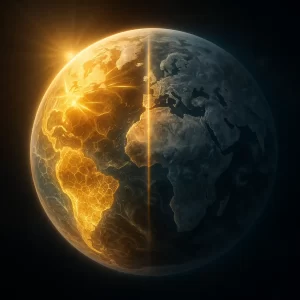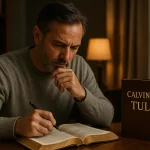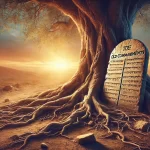
Thermodynamics and Creation #
This guide is not a deep scientific inquiry of the Laws of Thermodynamics. After all, volumes have been written about the subject. Rather, this guide answerers how to use thermodynamics in apologetics using the fundamental principles of thermodynamics for apologetic conversations in everyday life (with neighbors, friends, family, etc.).
Zeroth Law of Thermodynamics #
If two systems are each in thermal equilibrium with a third system, then they are in thermal equilibrium with each other.
Implications #
This law defines temperature and provides the foundation for measuring it. It shows that energy exchange moves systems toward equilibrium or balance.
In Everyday Terms #
If two things are both the same temperature as a third thing, they are also the same temperature as each other. For example, if your drink, your cup, and your hand all feel the same, they have reached the same temperature. Energy naturally spreads out until everything reaches balance.
How Zeroth Law Challenges Evolution #
Evolution requires increasing complexity over time, yet the Zeroth Law reflects a universe that constantly seeks equilibrium. Living systems resist equilibrium through highly organized and energy-dependent processes. Such organization cannot arise naturally from a state that constantly pushes toward balance and uniformity. Without an outside energy-directing mechanism, such as an intelligent Creator, the formation of structured, self-replicating life contradicts this basic physical tendency.
In Simple Terms #
Think about how everything in nature tries to even out. Hot things cool down, and energy spreads out. But living things are the opposite. They stay organized and full of activity. That does not happen by itself. It is like expecting your phone to charge itself by being near a dead battery. Without something smarter than nature arranging things, life would not happen on its own.
Apologetic Overview #
Creationist Position:
The Zeroth Law shows that all systems naturally seek equilibrium. Life, however, resists equilibrium through purposeful organization and energy control. This points to design, not accident.
Evolutionary Rebuttal:
The Zeroth Law is only about temperature and thermal balance. It does not deal with biological order or evolution. Living things are not in equilibrium; they are open systems that stay organized through natural processes.
Apologetic Response:
While the Zeroth Law directly concerns temperature, its principle still reveals a universal tendency toward balance and uniformity. Evolution depends on the opposite: constant increases in complexity and information. Life resists equilibrium only because it is sustained by a pre-existing code and energy direction. Organization requires intelligence. The laws of physics show how things behave, but not how life’s order began. The Bible offers the missing explanation: “He is before all things, and in Him all things hold together” (Colossians 1:17).
In Common Words #
Nature wants everything to even out, but life runs uphill against that flow. That kind of organization needs direction. A living cell acts like a computer running on constant instruction, not like a puddle of warm water trying to balance its temperature.
First Law of Thermodynamics in Creation (Law of Energy Conservation) #
Energy cannot be created or destroyed. It can only change forms. The total amount of energy in a closed system remains constant.
Implications #
This law shows that energy and matter are finite. They do not appear or vanish by themselves. All physical changes involve transforming existing energy, not producing new energy.
In Everyday Terms #
Energy works like a closed bank account. You can move it, spend it, or store it, but you cannot add more from nowhere. The same amount of energy has existed since the beginning.
How the First Law Challenges Evolution #
Evolutionary theory assumes that the universe, life, and information somehow originated naturally from non-living matter. However, the First Law tells us that neither matter nor energy can create itself. The question then becomes: where did the original matter and energy come from? The only rational conclusion is that an external, non-physical source introduced them. This aligns with the biblical claim that God created all things from nothing.
In Simple Terms #
If energy cannot pop into existence, then the energy that powers stars, planets, and life must have come from somewhere else. Nature cannot make itself from nothing. It is like claiming your house built itself with no builder and no materials. That just does not happen.
Answering the Rebuttal Question: If Earth is a closed system, how do we explain the energy from the Sun? #
The Earth receives energy from the sun, yet scientists generally agree that Earth is a closed system. The key point is not just the presence of energy, but whether that energy is organized and directed in a way that produces specified complexity like DNA, cellular structures, and life processes.
The Second Law still applies because raw energy alone does not build complexity. For example, sunlight shining on a pile of bricks does not build a house. Heat and light from the sun can cause chemical reactions or sustain existing life, but they do not explain the origin of organized systems or increase information without a guiding mechanism.
In both science and everyday life, order only arises from energy when intelligence or information directs it. Machines, computers, and biological systems require specific instructions, not just energy input. Evolution requires a step-by-step increase in both order and genetic information, and the Second Law tells us that nature does not move in that direction by itself.
In common words #
Getting energy from the sun is like having gasoline in your car. The gas gives power, but without a driver, the car goes nowhere. In the same way, sunlight provides energy, but without a guiding process, it cannot turn simple chemicals into living cells. Energy alone does not build life any more than fire builds skyscrapers.
Apologetic Overview #
Creationist Position:
Energy and matter cannot be created or destroyed. Therefore, the universe could not have created itself. This supports the need for a Creator.
Evolutionary Rebuttal:
The First Law applies only within the universe after it exists. The Big Bang theory explains the beginning of energy and matter from a singularity, which may not be subject to current physical laws. Evolution deals with life after that, not with the origin of the universe.
Apologetic Response:
The rebuttal admits that the First Law does not explain the origin of matter and energy. The Big Bang still requires a cause outside the system. Even if the laws began at a singularity, something or someone had to trigger that event. Science shows that matter and energy cannot come from nothing. The Bible uniquely provides that cause: “In the beginning God created the heavens and the earth” (Genesis 1:1). Energy and matter began when God willed them into being.
In Common Words:
You cannot have an explosion without something to explode. Energy cannot appear from nothing. The Big Bang still needs a spark. The logical answer is not “nothing did it” but “Someone did.”
Second Law of Thermodynamics (Law of Entropy) #
The total disorder (entropy) of a closed system will always increase over time. It never decreases on its own.
Implications #
This law explains why all systems, left to themselves, become less organized. As energy becomes less usable, disorder increases. To reverse disorder, energy must be directed with purpose and control.
In Everyday Terms #
Things naturally go from order to chaos. A new car rusts, food spoils, and rooms become messy. Without deliberate energy and effort, nothing becomes more ordered or complex.
How It Challenges Evolution #
Evolution teaches that simple life forms gradually became more complex over billions of years. Yet the Second Law shows that natural systems lose order over time, not gain it. Life’s complexity, genetic information, and biochemical precision cannot come from random, unguided processes that constantly move toward disorder. For evolution to work, the Second Law would need to run in reverse. That would mean chaos producing order, which is contrary to every observation in physics.
In Everyday Terms #
Imagine dumping a pile of Lego bricks on the floor and expecting a working robot to assemble itself. That is what evolution asks us to believe. But the Second Law tells us that without help, things do not get better, they fall apart. Life is like the robot. It needs a builder, not just random pieces.
Apologetic Overview #
Creationist Position:
Entropy increases in all natural systems. Things move from order to disorder, not the other way around. Evolution claims the opposite, that life becomes more complex and organized over time.
Evolutionary Rebuttals:
The Earth is not a closed system. The sun provides energy that allows local decreases in entropy. (We have already addressed this above.)
Order can arise naturally, such as in snowflakes or crystal structures, without violating the Second Law.
Evolution is guided by natural selection, which directs change toward greater adaptation.
Apologetic Response:
Energy from the sun does not explain how that energy becomes organized into living systems. Sunlight can heat, melt, or burn, but it does not create information. The Second Law allows local order only when energy is directed by a pre-existing system. A plant can use sunlight because it already has a DNA program to do so. The sun alone cannot turn chemicals into a living cell. Order in crystals or snowflakes is repetitive, not informational. Biological systems require coded information, not simple geometric patterns. Natural selection can refine existing information but cannot create new genetic code without an intelligent source. “For every house is built by someone, but the builder of all things is God” (Hebrews 3:4).
Third Law of Thermodynamics #
As a system approaches absolute zero, which is 0 Kelvin, the disorder or entropy of the system approaches its lowest possible value.
Implications #
This law tells us that it is impossible to cool something all the way down to absolute zero. At that temperature, all molecular motion would stop. No process can reach this temperature completely.
In Everyday Terms #
Imagine freezing something until it cannot move at all. That is absolute zero. But it is impossible to reach that point. The closer you get, the harder it becomes to remove more energy.
How It Challenges Evolution #
The Third Law points to a finite limit to the universe’s energy. The cosmos is gradually cooling and will eventually reach thermal death, where no energy remains to drive processes. If the universe had existed forever, it would already have reached that state. This means it had a beginning or starting point of high order and energy. Evolutionary models depend on endless time and energy, but the Third Law shows both are limited. This supports the concept of creation: a universe that began with order and energy supplied by an intelligent cause.
In Simple Terms #
If the universe were really billions of years older than we think, it would have already run out of usable energy. That means it had to start somewhere and sometime. Evolution needs endless time and energy to work, but the laws of nature say we do not have either.
Apologetic Overview #
Creationist Position:
As systems lose energy, they move toward complete stillness and disorder. If the universe were eternal, it would already have reached this state. This means the universe had a beginning and is running down, pointing to a Creator who started it.
Evolutionary Rebuttal:
The Third Law applies only to systems near absolute zero. It does not affect biological or evolutionary processes. The heat death of the universe will happen far in the future and does not impact life now. Evolution can occur long before that happens.
Apologetic Response:
While the Third Law focuses on behavior near absolute zero, it reinforces the truth that energy is limited. The universe is slowly cooling and moving toward an end. This contradicts the idea of an eternal, self-sustaining cosmos. If energy has limits, then time and order also have limits. Something must have supplied both at the beginning. The Bible identifies that cause as the eternal Creator who “stretches out the heavens” (Isaiah 42:5). Science shows a universe winding down; Scripture reveals the One who wound it up.
In Common Words:
If your flashlight battery keeps draining, it means someone had to charge it in the first place. The universe is running out of usable energy. That means it was charged at the beginning by something greater than itself. Evolution cannot explain who turned it on.
Thermodynamic Reference Chart for Apologetics #
Law Key Evolutionary Claim Biblical Apologetic Response
Zeroth Life is an open, non-equilibrium system. Equilibrium trends still oppose natural increases in order. Life’s organization demands intelligence.
First The law applies only after the universe began. The beginning still requires a cause. God alone can create from nothing.
Second Energy from the sun allows local decreases in entropy. Energy alone cannot create information or life without design.
Third The law applies only near absolute zero and far in the future. The universe’s energy decay proves it had a beginning and needs a Sustainer.








